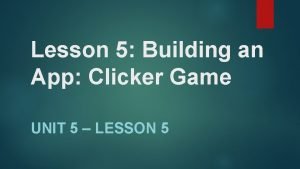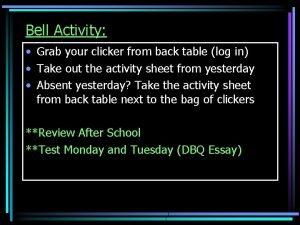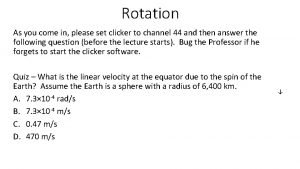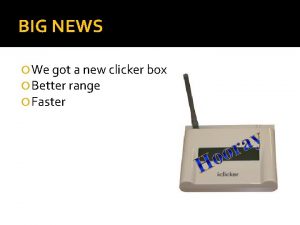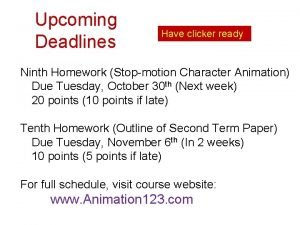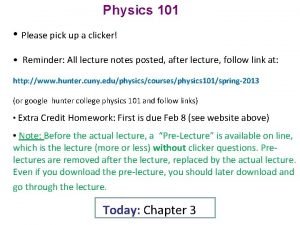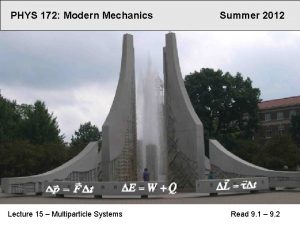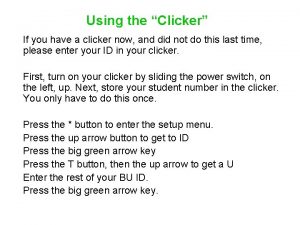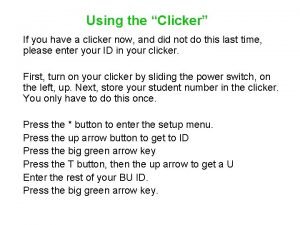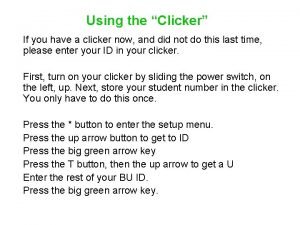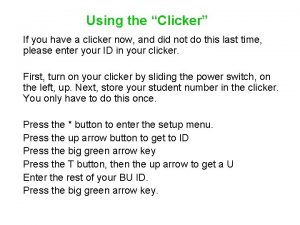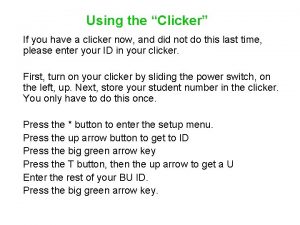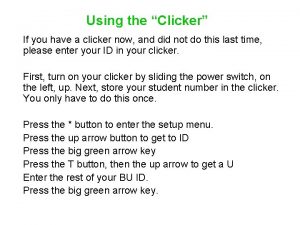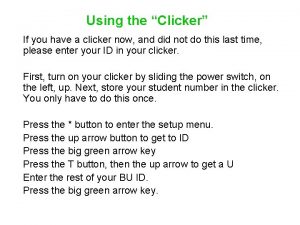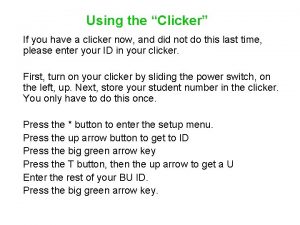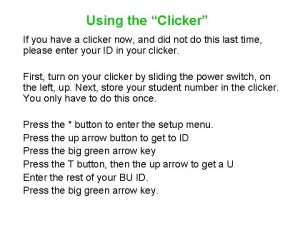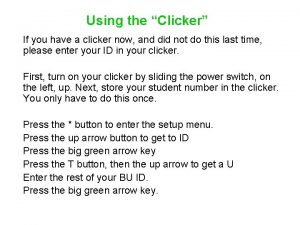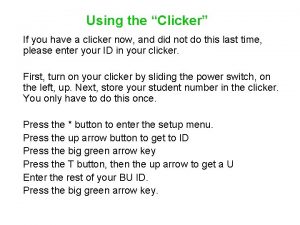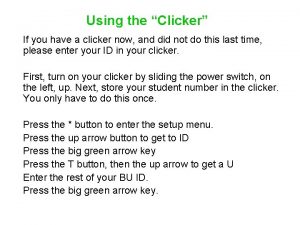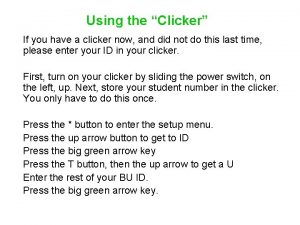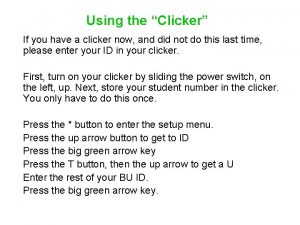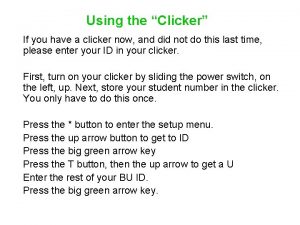Using the Clicker If you have a clicker


















- Slides: 18

Using the “Clicker” If you have a clicker now, and did not do this last time, please enter your ID in your clicker. First, turn on your clicker by sliding the power switch, on the left, up. Next, store your student number in the clicker. You only have to do this once. Press the * button to enter the setup menu. Press the up arrow button to get to ID Press the big green arrow key Press the T button, then the up arrow to get a U Enter the rest of your BU ID. Press the big green arrow key.

Acceleration of the Earth What is the speed of the Earth as the Earth travels in its circular orbit around the Sun? What is the acceleration associated with this orbital motion?

Acceleration of the Earth r = 150 million km = 1. 5 × 1011 m T = 1 year ≈ π × 107 s The acceleration is:

Vertical circular motion Our goal today is to understand various situations in which an object travels along a vertical circle. Examples • Water buckets • Cars on hilly roads • Roller coasters

Ball on a string When a ball with a weight of 5. 0 N is whirled in a vertical circle, the string, which can withstand a tension of up to 13 N, can break. Why? Where is the ball when the string is most likely to break? What is the minimum speed of the ball needed to break the string?

Ball on a string – free-body diagrams Sketch one or more free-body diagrams, and apply Newton’s Second Law to find an expression for the tension in the string. At the top At the bottom

A water bucket As long as you go fast enough, you can whirl a water bucket in a vertical circle without getting wet. What is the minimum speed of the bucket necessary to prevent the water from falling on your head? The bucket has a mass m, and follows a circular path of radius r.

Free-body diagram for the water bucket Sketch a free-body diagram for the bucket (or the water), and apply Newton’s Second Law.

Roller coaster On a roller coaster, when the coaster is traveling fast at the bottom of a circular loop, you feel much heavier than usual. Why? Draw a free-body diagram and apply Newton’s Second Law.

Roller coaster On a roller coaster, when the coaster is traveling fast at the bottom of a circular loop, you feel much heavier than usual. Why? Draw a free-body diagram and apply Newton’s Second Law. Take positive up, toward the center of the circle. Your apparent weight is equal to the normal force acting on you.

Driving on a hilly road As you drive at relatively high speed v over the top of a hill curved in an arc of radius r, you feel almost weightless and your car comes close to losing contact with the road. Why? Draw a free-body diagram and apply Newton’s Second Law.

Conical pendulum A ball is whirled in a horizontal circle by means of a string. In addition to the force of gravity and the tension, which of the following forces should appear on the ball’s free-body diagram? 1. 2. 3. 4. 5. 6. A normal force, directed vertically up. A centripetal force, toward the center of the circle. A centripetal force, away from the center of the circle. Both 1 and 2. Both 1 and 3. None of the above.

Conical pendulum (see the worksheet) Sketch a free-body diagram for the ball. Apply Newton’s Second Law, once for each direction.

Conical pendulum (work together) Sketch a free-body diagram for the ball. Tsinq q Axis of rotation T q y Tcosq x mg Resolve Choose Apply Newton’s Second Law, once for each direction. x-direction: T sinq = m(v 2/r) y-direction: T cosq = mg Solve:

Gravitron (or The Rotor) In a particular carnival ride, riders are pressed against the vertical wall of a rotating ride, and then the floor is removed. Which force acting on each rider is directed toward the center of the circle? 1. 2. 3. 4. 5. A normal force. A force of gravity. A force of static friction. A force of kinetic friction. None of the above.

Gravitron (see the worksheet) Gravitron simulation Sketch a free-body diagram for the rider. Apply Newton’s Second Law, once for each direction.

Gravitron (work together) Sketch a free-body diagram for the rider. He’s blurry because he is going so fast! FS Axis of rotation FN mg y x Apply Newton’s Second Law, once for each direction. y direction: FS - mg = may = 0 (he hopes) x direction: FN = max = m (v 2/r)

Whiteboard
 Samuel they have rejected me
Samuel they have rejected me Which solid figure has 6 faces, 8 vertices, and 12 edges?
Which solid figure has 6 faces, 8 vertices, and 12 edges? Math clicker
Math clicker E clicker
E clicker +audience +response +clicker
+audience +response +clicker Lesson 5 building an app clicker game
Lesson 5 building an app clicker game Earth clicker
Earth clicker Heart rate clicker
Heart rate clicker Hitler clicker
Hitler clicker Clicker stop motion
Clicker stop motion Cooi clicker
Cooi clicker Umbc clicker
Umbc clicker Clicker box
Clicker box Youtube youtube
Youtube youtube Clicker stop motion
Clicker stop motion Clicker
Clicker Phys 172
Phys 172 Buzka clicker
Buzka clicker Salt clicker
Salt clicker





